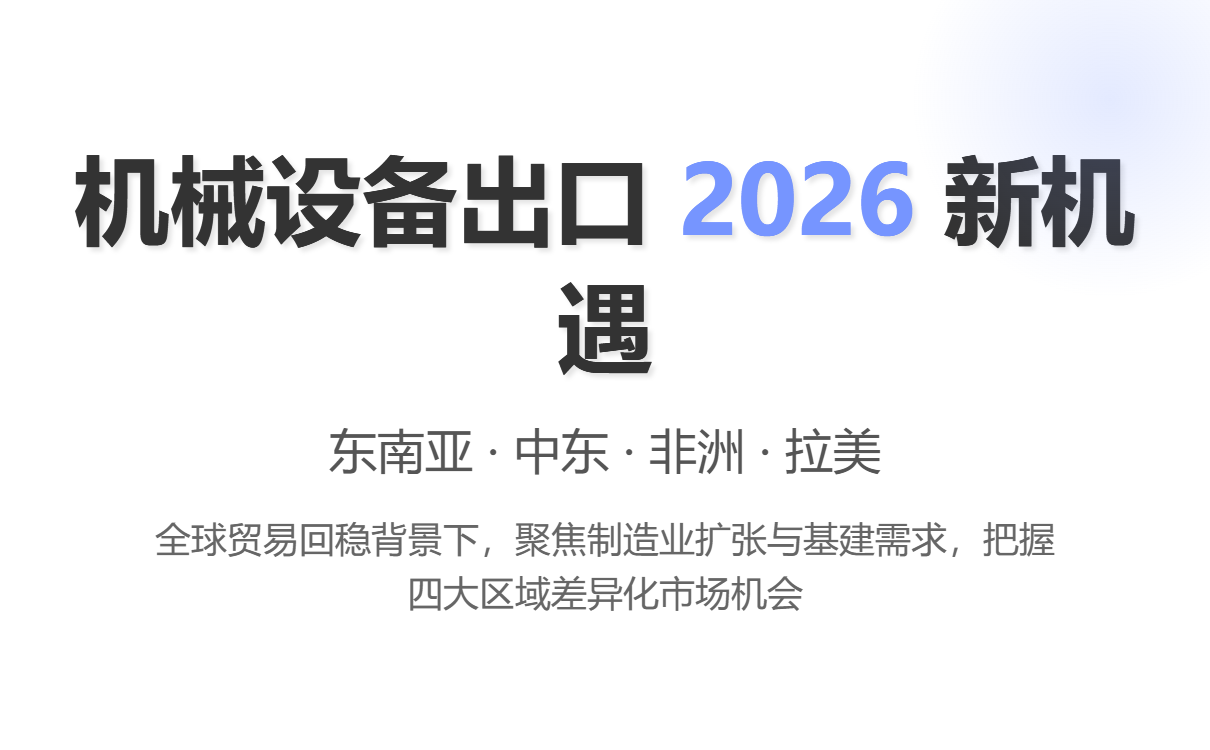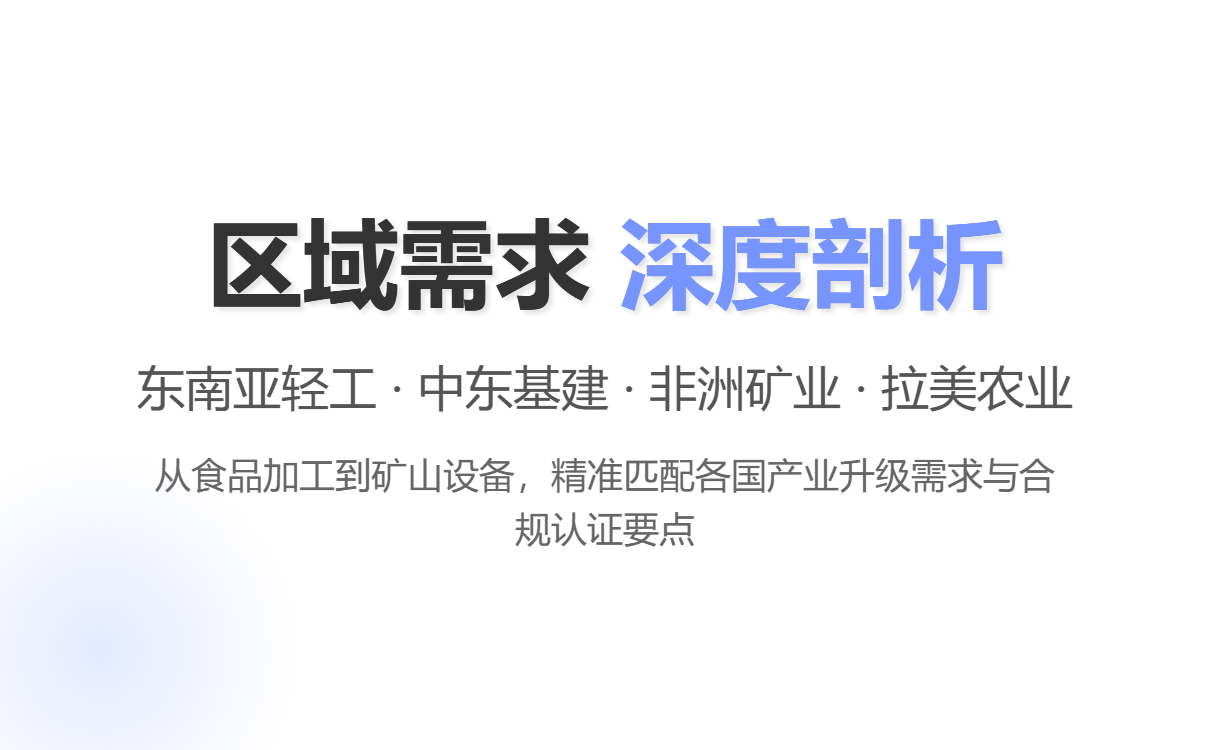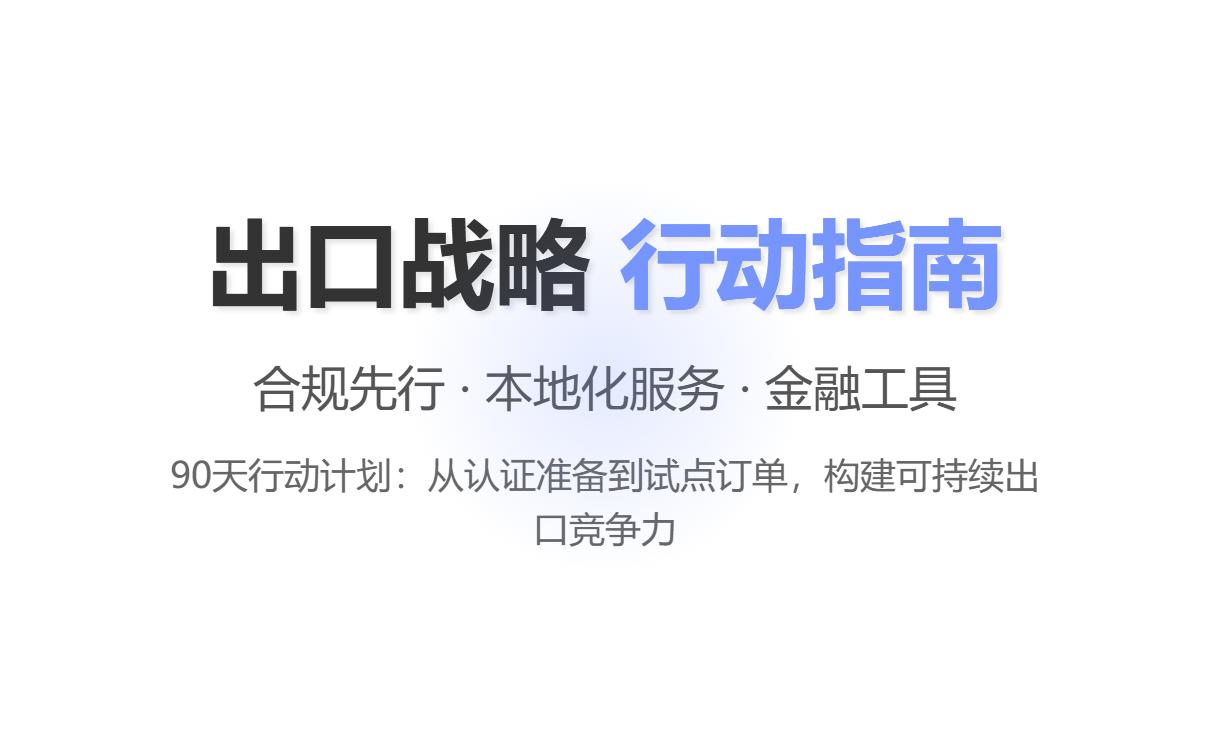
Introduction
Against the backdrop of a global trade recovery expected in 2024–2025 and rising demand from South-South trade and developing countries, machinery and equipment exporters must shift their focus from "who has the money to buy" to "who is putting into production, in which industries are they expanding, and what are the import barriers." Based on the latest authoritative data from the World Bank, UNCTAD, the African Development Bank (AfDB), international trade statistics agencies, and various compliance/certification bodies, the following provides in-depth analysis and actionable recommendations for four major regions: Southeast Asia, the Middle East, Africa, and Latin America. Related reading: 2026 Global Machinery and Industrial Equipment Industry Outlook: 5 Opportunities and 3 Risks

Southeast Asia : Manufacturing and food processing, electronics and light industry are expanding steadily. It is the market with the fastest "landing" in the short to medium term, and is suitable for small and medium-sized processing machinery, packaging and automation equipment, and agricultural post-processing equipment.
The Middle East (Gulf) : Primarily focused on large-scale infrastructure, energy, and urban development (electricity, ports, airports, petrochemicals, and desalination), it has a high demand for heavy engineering machinery, power generation/transformation equipment, marine engineering, and petrochemical equipment. However, compliance and certification (such as SASO/G-Mark) and local procurement preferences raise the entry barriers.
Africa : Growth rates vary widely, but there is strong long-term demand for mining, road/bridge/port construction and agricultural mechanization; projects are mostly driven by a mix of multilateral development banks, foreign investment and national budgets, making them suitable for suppliers with medium and heavy equipment and strong localization capabilities.
Latin America : Mainly Brazil, Mexico, Chile, and Peru, with stable demand for agricultural machinery, mining machinery, and food processing/processing industrial equipment; however, local compliance (such as Brazil's INMETRO and Mexico's NOM) and protectionist trade measures need to be given serious consideration.
(The above judgment is based on a summary analysis of investment and trade by various official/international organizations in 2024-2025: global trade remained resilient compared to the first half of 2025, and developing economies significantly boosted manufacturing and infrastructure.)

Fundamental Investment : Driven by regional supply chain restructuring and foreign investment relocation, the electronics, food processing, light industry, and auto parts sectors continue to attract investment; governments worldwide are promoting manufacturing upgrades and industrial park expansion. World Bank and regional industry research indicate that Southeast Asia remains a hotspot for foreign-invested manufacturing.
Main types of machinery required :
Electronics/EMS Support: SMT auxiliary equipment, testing/inspection equipment, and automated placement/assembly equipment.
Food/agricultural processing: cleaning, cutting, packaging, cold chain and canning equipment (especially in Indonesia/Vietnam).
Light manufacturing automation: CNC, injection molding, motors/frequency converters, etc.
Key points for market entry : Price-sensitive but with high requirements for "easy maintenance, replaceable parts and localized services"; after-sales concerns can be reduced by local distribution or establishing service centers.
Basic investment : Driven by sovereign wealth funds and diversified national strategies such as "2030/2035", there are huge infrastructure projects, airport/port expansions, energy (natural gas, hydrogen, photovoltaic) and urban projects under construction or in the planning stage.
Main types of machinery required :
Heavy construction machinery (excavators, bulldozers, cranes) and road and bridge equipment.
Energy sector: generator sets, transformers, seawater desalination and petrochemical processing equipment.
Port/logistics equipment: quay cranes, conveyor systems, forklifts.
Compliance/Policy Highlights : Gulf countries are increasingly stringent on import compliance requirements (G-Mark/SASO, etc.), and large-scale projects often involve bidding and prefer suppliers with local joint ventures or local service commitments. Obtaining relevant certifications in advance and preparing local cooperation and long-term maintenance plans are crucial.
Fundamental investment : African countries have long-term investment plans in roads, energy, mining, and agricultural modernization, with multilateral development banks (AfDB, World Bank) and foreign direct investment being the main sources of funding. Short-term projects are scattered, but long-term demand is enormous.
Main types of machinery required :
Mining/mining equipment (crushing, screening, mineral processing) requires high durability and on-site maintenance capabilities.
Agricultural machinery (tractors, seeders, combine harvesters and post-harvest equipment), especially in agricultural modernization projects in North and East Africa.
Infrastructure machinery and power equipment (generators, transformers).
Key points for market entry : Logistics costs and after-sales price comparison are important; establishing relationships with international development project contractors (EPCs), participating in bidding, and providing equipment financing/leasing solutions will significantly increase the probability of winning bids.
Fundamental investment : Latin America has stable investments in agricultural mechanization, mineral processing, and food processing; meanwhile, Mexico and Brazil are attracting investment in automobiles and auto parts due to regional supply chains and nearshoring opportunities.
Main types of machinery required :
Agricultural machinery (large agricultural machinery, irrigation systems, grain post-processing).
Mining equipment (continued demand for copper mines in Chile and Peru).
Food/beverage processing equipment and packaging machinery.
Compliance/Policy Highlights : Local certification systems, such as INMETRO in Brazil and NOM in Mexico, often serve as barriers to market entry; Portuguese/Spanish documentation, local agents, and a long-term spare parts supply chain are key.
Middle East (GCC) : Compliance systems such as G-Mark/SASO (Saudi Arabia) require mandatory certification for certain electrical and low-voltage equipment. Importation requires registration in the SABER/GSO system and obtaining SCoC/PCoC (Saudi Arabia example). Non-compliant goods will be detained.
Brazil : INMETRO mandates certification for certain industrial electrical equipment, measurement and safety-related products; applications typically require a local representative and passing testing/factory audits.
Mexico : There are many NOM standards, and electronic/electrical/environmental products must comply with the corresponding NOM; some temporary import items are exempt.
Africa/Southeast Asia : Most countries accept or refer to IEC/ISO standards, but specific projects (government infrastructure or mining) may have additional contractual technical specifications; some countries have strict requirements for localized services/sponsors.
First, select a niche market, then choose a country : Don't just generalize about "Southeast Asia," but rather select 1-2 target countries based on industry (food processing, mining, port equipment, energy) (e.g., prioritize Vietnam/Indonesia for food machinery, and South Africa/Chile for mining machinery). Reason: Differences in demand and compliance lead to vastly different returns on investment.
Compliance First : Large projects (Middle East, Brazil) often experience delivery delays due to certification issues. Include obtaining mandatory local certifications (G-Mark/SASO, INMETRO, NOM) in your project cost and time budget before bidding.
Establish "service + spare parts" capabilities : Especially in Africa and Latin America, the ability to provide rapid spare parts and on-site repairs is a more decisive factor in winning bids than simply offering the best price. It is recommended to partner with local service providers or establish regional warehouses.
Participating in EPC/Multilateral Bank Projects : A large number of infrastructure projects in Africa and Latin America are contracted by development banks or large EPC contractors. Establishing relationships in advance and preparing compliance documents will increase the chances of winning the bid.
Financial instruments and localized business models : Providing buyers with financing, installment, or leasing (OPEX) solutions can overcome procurement budget constraints and increase closing rates. Large-scale projects in the Middle East also prefer long-term services and financing packages.
Geopolitical/Exchange Rate and Payment Risks : Projects in some Middle Eastern and African countries are affected by political and oil price fluctuations; Latin American countries may face currency devaluation and protective tariffs. It is essential to transfer these risks to contracts (letters of credit, standby guarantees) and insurance.
Compliance delay costs : Certificate preparation time is often underestimated (weeks to months), affecting delivery time and cash flow.

Determine your preferred industry-country combination (maximum 2 industries × 2 countries) .
Examples: Food processing → Vietnam/Indonesia; Mining equipment → Chile/South Africa.
Compliance pre-assessment : List the mandatory certifications required by the target country (G-Mark / SASO, INMETRO, NOM, project-specific regulations), and estimate the time and cost.
Establish one local service or spare parts partner (dealer/repairman).
Prepare a tender document package (technical manual, test report, after-sales and spare parts SLA, financing plan) to facilitate a quick response to EPC/government tenders.
Initiate one pilot order (including after-sales commitment) and record KPIs (delivery time, first failure rate, spare parts response time) .
If you want quick returns and low investment threshold , prioritize Southeast Asia (food processing, electronic components, light industrial automation) as your first stop.
If the target is a large single transaction with high compliance/bidding requirements , the Middle East (energy, infrastructure) can be considered, provided that certification and localization services are prepared in advance.
Africa is suitable for long-term strategic investment, and it is important to focus on relationships with multilateral institutions and EPCs; Latin America, on the other hand, needs to carefully integrate with local certifications such as INMETRO/NOM and adopt strategies for language and spare parts.
.png?x-oss-process=image/resize,h_100,m_lfit/format,webp)
.png?x-oss-process=image/resize,h_100,m_lfit/format,webp)

.png?x-oss-process=image/resize,h_100,m_lfit/format,webp)
.png?x-oss-process=image/resize,h_100,m_lfit/format,webp)
.png?x-oss-process=image/resize,h_100,m_lfit/format,webp)
.png?x-oss-process=image/resize,h_100,m_lfit/format,webp)
